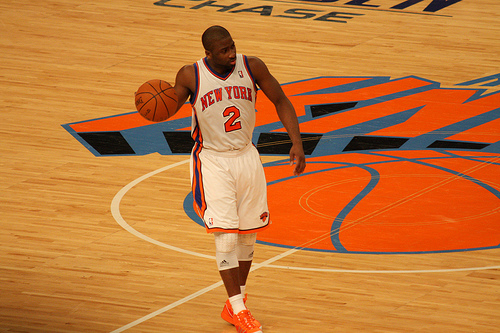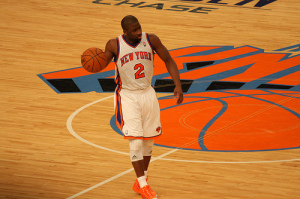Defence off the Ball: When to Steal

The Steal like Shot Blocking is one of the most poorly understood skills in the game of basketball. Within the rules, but very rarely ever seen to be taught. The steal has the ability to change a game, swing momentum and frustrate an opposition. Ninety percent of the challenge behind stealing a ball comes down to being in the right place at the right time, or more commonly called defensive awareness. Being able to pick the right situations from the wrong will lead to more success and reduce the adverse risk of attempting to make a steal only to find that a player has been left unguarded and free on the court.
By explaining to players when the right situations are for a steal to be attempted a coach helps define what an acceptable risk is without completely shutting down the ability of a player to attempt this technique.
Spin

While playing off the ball in the backcourt a good opportunity is always present to steal the ball if the dribbler attempts to spin. This is because the action of the spin means the dribbler will often lose sight of the direction they are heading momentarily. This creates a wider than usual window of opportunity for the off the ball defender to cover ground and be at the right point, at the right time.
Some dribblers are more prone to utilising the spin move than others. For those players who heavily use the technique the consequences of a steal or two can break their confidence and really affect their entire game. Not to mention a steal in the backcourt often leads to a scoring opportunity.
Low Post
Playing in the post position is a very challenging role. Players find this area of the court to be where the heaviest amount of contact is often made and tolerated by officials. Offensive players in the low post often find themselves having to go “all in” when attempting a post move so they are able to play through the defensive contact and still make a scoring play.
For this reason the first dribble of the post player when attempting a move the basket is often very powerful and they readily over commit to the action. Once an off the ball defender starts to understand the pattern of the movement by the post player, attempting to steal the ball on the first dribble becomes a very effective strategy.
Many post players only use one dribble when working into the low post so this one, and sometimes only dribble is the slim opportunity for the steal to happen. Timing must be perfect.
Another benefit of this time is that when performing the low post scoring movement the offense player will often initiate contact in an attempt to take as short a route to the basket as possible. This by way of the offensive players own initiation of contact, reduces the range of angles possibly taken to the basket. This allows a defender off the ball attempting to make the steal to have a greater chance of success in picking the right path the post player is likely to take to the basket.
On-Ball Screen
When players are trained in how to use an on-ball screen effectively they are often taught to take a minimum of two dribbles to assist with separation from the screener, achieving maximum speed and time for assessing the array of options available. It is following the first dribble that an opportunity for a steal is at its greatest.
Following the first dribble the player is working their way up to full speed. This makes changing directions or being able to fully anticipate everything happening on the floor that little bit harder for the dribbler. This is the ideal scenario for attempting a steal.
Another aspect that makes this time beneficial is because as a natural habit of separating the ball from the on-ball defender, the dribbler will normally have the ball on the outside of their body so to shield each dribble. This limitation for where the ball is placed further increases the chances of success for the defender off the ball attempting the steal.
As mentioned earlier with the post player movement, a similar situation is reflected in the dribbler once exiting the screen. Because of the on-ball pressure and often contact the ability to change direction is limited and a defender off the ball looking to make a steal should be able to anticipate the path of the offensive player more easily.
The steal forms a very valuable tool which can be overused. However if well-drilled and good instructions is provided about the right type of scenarios to attempt a steal, than success can be achieved with acceptable level of risk being undertaken.


Good thoughts on when to attempt steals. There’s another time I would add: when a person is dribbling fast (on a break) toward you. If it’s timed right, the defender can attack the dribbler at the time the ball hits the floor and get a hand on the ball. Because the dribbler is coming at the defender, the defender attacking in the opposite direction closes the gap too quickly for the dribbler to react. Of course, if the defender misses, he’s taken himself out of the play, so players need to use this judiciously – but that applies to all the situations you listed above, too!
Hi Coach, attempting to steal the ball at anytime during a game always has some risk. For more savvy players they simply become better at judging the times in which to gamble, and when to not commit. Like in the example you have provided, if a player is good enough in the full court this is a very good scenario for an attempted steal. Especially if the dribbler is not a primary ball handler like the situation created sometimes through full court pressure where players not normally adapt at dribbling suddenly find themselves with the ball.
Good info coach. I learned an on ball stealing technique many years ago from Lindsey Hunter while I was in high school & he was at JSU. Going for the steal as soon as the ball handler starts his downward dribble is easy picking. It works best when a player opens up getting ready to make a move or looking to turn the corner. As soon as it leaves their fingertips it’s rip city. #thelittlethings